Labor Force Participation and "Disability"
"It's almost as though some entity is paying them. It's almost as if somebody is not letting them fail."


In another post I explored the relationship between labor force participation for women, versus fertility rates. In that analysis, I stumbled upon the fact that women's labor force participation in the United States peaked around 2008, and has only declined since then. Initially, I thought this could be due to millennial women dropping out of the labor force to raise babies, since the fertility data shows that women in their thirties are having more babies now than they did in decades past.
However, when I compared men's labor force participation to that of women, I saw that men are leaving the labor force too, and in 2008 this trend accelerated for men (see the chart I made below). Millennials are much more progressive than previous generations about "stay at home dads," so this trend could be related to family planning for men too, which could be great news for the economy. Unfortunately, I could not find the necessary granularity in the data to assess whether dads might be dropping out to raise babies. It is possible that this is in fact what is happening.
As always, I turned to Google to get a snapshot of the prevailing theories. A search for "US shrinking labor force participation," returned a flurry of studies, articles, think pieces, and video segments about the issue. Most of these sources blamed what I will call the "Man Sloth" hypothesis. A lot of members of the college-educated "chattering classes" are convinced that lazy blue collar men would rather go on "Disability" than retrain away from manufacturing, to lower-paid but plentiful service-sector jobs.

A decade ago, an NPR investigative report titled, "Unfit for Work: The startling rise of disability in America," described a small town in Alabama, in which 25% of working age men survive on disability checks, after the nearby mill, which employed them, closed. "Welfare," which is temporary cash assistance, is paid for with state funds, whereas "Disability" is paid for by the federal government. This apparently creates a powerful incentive for states to reclassify people. What is more, once someone is "disabled," they are no longer counted as unemployed, as they have technically dropped out of the labor force.

The 2013 NPR article spawned numerous responsive pieces, many with salacious headlines, like "Disability Insurance: America's $124 Billion Secret Welfare Program" (Weissman, The Atlantic, 2013). David Autor, an MIT economist describes disability as, "kind of an ugly secret of the American labor market." The word "secret" implies something premeditated and intentional. In hindsight, I still remember this news cycle. For a certain class of people, the idea that disability is the new "welfare" became settled truth ten years ago.
I decided to look into the 2023 disability data, and what I found was surprising.
"It's almost as though some entity is paying them."
The most salient formulation of the "Man Sloth" hypothesis came from the CBS Mornings show, in a segment, which aired on Jan 26, 2023. The segment blurb sets the stage: "Around seven million men in their prime working age neither have jobs nor are looking for one, creating a huge hole in the labor market and costing businesses in male-dominated fields like manufacturing millions of dollars."
Dirty Jobs host Mike Rowe is the major authoritative voice in this CBS segment. CBS reporter Tony Dokoupil asks Rowe, how is it that these millions of unemployed men, "still have money for a bag of chips?" "It's almost as though some entity is paying them," Rowe replies. He goes on, "It's almost as if somebody is not letting them fail. It's as if some giant parent somewhere has..." "An uncle, maybe?" Dokoupil interjects. "Could be a rich uncle, yes. Could be a very wealthy uncle," Rowe emphatically agrees... referring of course to Uncle Sam.
This scene in which Mike Rowe distills the "Man Sloth" hypothesis for viewers is tough to watch. Here is Rowe, a multi-millionaire talking to a coiffed hunk of television host, comparing the US government to a bad parents. Why is Rowe being interviewed at all? As an actor, he cosplays dirty jobs. He doesn't actually do them! His forays into "dirty jobs" may be entertaining precisely because they're not really his job. Diving into a vat of raw sewage is funny on a dare. It's less funny as a daily occupation.
When Mike Rowe insinuates that the federal government is paying men to be sloths, I assume he means Social Security Disability Insurance (SSI and SSDI), because there simply are no other long-term cash-assistance programs available in the United States. Welfare is temporary and has work requirements. The Dirty Jobs host meets a lot of blue collar business owners, and these business owners tell him they cannot hire enough men to do the work because, "The Government." But are they even right? And why does Mike Rowe think it's acceptable to parrot their biases uncritically?
Social Security Disability pays a pittance–the median payout is less than $1,000 per month–but it is inflation adjusted, and it does typically qualify the recipient for Medicaid. Let us be clear, from a human perspective, it must be humiliating to identify as disabled. There are forms to fill out and doctors notes involved. On top of that, recipients resign themselves to a lifetime of poverty and dependence on government funds. In my mind, this is not a path you choose as a clever rapscallion trying to bilk the government out of a tiny bit money. It's a path you choose in desperation, for lack of other viable options.
Rather than accept that there may be structural problems in the US economy, which have rendered a large part of the workforce unemployable, it is far easier to blame these problems on a bunch of man-babies, who have latched onto the government teat... A decade has now passed since the NPR study was published, and I think it's worth revisiting the data, instead of blindly repeating the stale grievances of multi-millionaires.
What Even Is "Welfare" in 2023?
One of the hysterical claims of these disability panic articles pertains to the explosive growth of the disability program. The NPR piece shows us a chart titled, "Number of Former Workers on Disability." OK, yeah, it sure looks growthy. But even an unsophisticated person would ask what is going on with the rest of the population. Is it growing too? Is it aging? The chart footnote contains a link to see the normalized data: "To see the percentage of all eligible adults who are on disability." The link is broken.

Are the normalized numbers increasing? Because that is where I began my investigation into this issue. The first chart I charted (below) was a crude normalization, first by total population, and then by working age population. Disability data came directly from the Social Security Administration and population numbers came from the OECD and the United Nations WPP.
Ironically, on a percentage basis the disability number peaked around 2013, which was the year of what I am calling, "Disability Panic," which still haunts us today. Basically, ever since the NPR piece was published, numbers of disabled folks on a percentage basis have been declining. The other thing to notice is that there is a divergence in the data. Seemingly more and more working age people are going on disability, but "Working Age" is defined as ~20-65 years old, which is a huge bucket. It remains possible that working age people are getting older, and older people become disabled for all sorts of good reasons, which have nothing to do with sloth.

Again, let's look at the data. What is happening to the age of the US population? Well, it's getting older. Basically, the youthfulness of the US population peaked in 1970, when the big baby boomer cohort hit their twenties. Ever since 1970, the US population has gotten older and older and older, relentlessly. On this backdrop, it makes sense that there would be a higher percentage of people on disability, and this has nothing whatsoever to do with being lazy. Old age is a beast, and importantly, it's a beast that comes for all of us, or at least, those of us lucky enough to survive until the end of life without meeting untimely death.

If the nation keeps getting older, and more older people means more expected disabled people, then why did disability numbers start to decline in 2013? Well, if the nation keeps getting older, that means a bunch of people are aging out of disability. Once they cross retirement age, they move into the regular Social Security bucket. And eventually, they die. What should raise alarm is if we see growing numbers of younger folks on disability. Is this happening?
No. Decidedly, it is not happening. I charted the distribution of workers receiving disability payments on the chart below. As you can see, the younger cohorts are actually shrinking since the 1990s. The only group, which is adding folks to the disability rolls, is the Age 60+ group:

Looking at the age cohorts, it's clear that about 40% of current disability recipients are over 60 years old. The next largest cohort is over 50 years old. Of the alleged millions of people who receive disability benefits, only 20% of those are younger than fifty. Currently, about 8 million Americans receive disability (it's less but marginally so). This means that there are ~1.6 million Americans who are truly prime working age for manual labor (40's or younger), and receiving disability. Only half of this 1.6 million are men (see below), and some not insignificant proportion of this 800,000 are probably... hear me out on this one... actually disabled.
Looking at the data closely, we went from a headline that reads, "Millions of Prime Age Men Are Sitting on Their Asses Watching Porn on Your Dime," to "Some Fraction of 800,000 Prime Age Men Are Potentially Less Than Fully Disabled." By conducting an analysis, which was not especially sophisticated, we were able to discern that this "crisis" scale problem for the US economy is really just a passing blip. As the economy ages, a bunch of old men and women are going to go on disability, age, and then die.
What about the notion that this tiny fraction of the labor force, which refuses to work, is a "Man Sloth" problem? Are there really so many more men on disability, than there are women? Actually, no. Not anymore! in 1980, when the data for the NPR piece began, there was a substantial divergence, but that divergence was already narrowing when the panic pieces were written, and has all but disappeared now.


What do I think happened to precipitate the panic from a decade ago? Well, I think that the story we all feared was likely correct... for a while. Globalization and automation, i.e. selling out the working class, did in fact lead to a wave of prime age men signing up for disability payments. Some women were able to adapt from manufacturing and industrial labor, to service work. But now, many of those women have aged too, and are facing disability issues. In general, the number of younger people on disability has shrunken, and the problem seems to be going away. NBD.
What are the lessons here?
1) Normalize the opinions of rich people by their likely biases. This does not mean that rich people have worthless opinions. They have valuable opinions, which are likely to be skewed in their own favor, just like anybody else. Except that they get a mouthpiece more often. So remember to question their assumptions.
2) Normalize absolute numbers by relevant population denominators.
3) Remember that people are people, and they have real reasons to do what they do.
Most importantly, solving for the wrong problem, in all likelihood, will yield the wrong solution. It's still possible to take a shot in the dark and hit the mark, but it is not likely. Demoralizing disabled people is not going to solve the ultimate problem of our economy, which is aging demographics. Apparently, something has convinced the child-bearing capable men and women of the American Empire that they're better off having fewer children. I don't know if they are right or wrong, but if you want to fix disability, that is where the solution should focus.